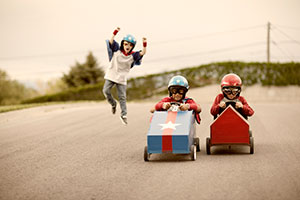Wear Your Helmet! ADHD Raises Risk of Head Injury

Watch your head, Fred! Did you know that children and teens with an ADHD diagnosis may be four times more likely to suffer a concussion than their peers?
Researchers in Taiwan recently reviewed the medical records of 72,181 children, teens, and young adults diagnosed with ADHD and compared them to an equal number of children, teens, and young adults without ADHD. The study results showed that the young people affected by ADHD were more likely to have a concussion or a traumatic brain injury during the study period than those in the control group.
The researchers tied the symptoms of ADHD to the increased risk for head and brain injury.
“Impulsivity is very much linked with risky health behaviors,” says Dr. Mu-Hong Chen, of Taipei Veterans General Hospital in Taiwan.
ADHD increases the possibility of serious injury
The most recent research on the connection between ADHD and head injury was published earlier this summer, but researchers have been highlighting the connection between ADHD and accidental injury for some time:
-
Children and young adults with ADHD are 4.6 times more likely to receive a traumatic brain injury
-
Athletes affects affected by ADHD have an increased risk of concussion compared to their teammates
-
There is a significantly increased risk of unintentional injury in daily life when a child has ADHD
-
Children and teens riding bicycles experience more “close calls” and actual accidents, especially when crossing streets with traffic
“If you ask kids and teens how to stay safe, most will have good strategies, but often implementation is a challenge for those with ADHD,” says Kimberly Gordon, MD, the medical director of the Berkeley & Eleanor Mann Residential Treatment Center and School in Baltimore, Maryland. “They tend to forget what they know or not follow through. Knowledge alone is not enough to prevent injury.”
Treatment helps to prevent injuries
Multiple research studies examining the connections between ADHD, injuries, and concussions or brain injuries all conclude that treatment for ADHD can reduce a young person’s risk for injury. Including medication as part of treatment was shown to be the most effective way to reduce injury risks.
“Perhaps the most relevant and striking result was the protective effect of ADHD medication [especially stimulant medications],” Maite Ruiz-Goikoetxea, MD, PhD, and colleagues write. “Clinically, our finding on the reduction of risk of [injuries related to ADHD] with medication highlights the importance of balancing risk and benefits when deciding to start, stop or continue medication. This should be considered during a balanced discussion over the pros and cons of medication therapy with parents so they can make an informed choice over therapeutic options that takes into account short- and long-term outcomes.”
Dr. Ruiz-Goikoetxea adds that medication holidays during the summer and school vacations should also be considered carefully because there is a heightened risk of injury during those times of year, when children are outside and more active, especially in sports. When safety is taken into consideration, many children would benefit from staying on medication rather than having a medication holiday, she writes.
What you can to decrease risk of injury
While no plan can guarantee 100 percent protection, you can take some steps to help your child or teen reduce the possibility of injury or traumatic brain injury related to ADHD.
-
Remember that ADHD affects maturity and decision-making abilities. Help young people to choose activities that meet their developmental abilities, even if the activities might seem a little “young” for them.
-
Make sure children and teens have and always use appropriate safety equipment when playing sports. Protective gear is designed to decrease the risk of serious injury, whether children participate in bicycling, skating, football, softball, lacrosse, or any other sport. Make it a family rule that children use the right equipment when playing sports or other outdoor activities.
-
For younger children, create a safe play environment. If you have one, your backyard can be set up for children to play and explore while still under a watchful eye. Make sure all swing sets, playhouses, and tree houses are in working order and have strong walls or railings. If there are “fall zones” from climbing structures, make sure there are no objects left in those areas and that they are cushioned appropriately.
-
Teach children how to cross the street and practice with younger children regularly. Sometimes making a family rule that a child can only cross the street with a “buddy” (parent, older child, or a friend) can help curb impulsivity. Teach children to be cautious about oncoming traffic and to wait until a car passes before crossing.
-
Practice various situations your child is likely to encounter. Offer your child examples of how to act in those situations and role play what to do.
Playing it safe
Children and young people will take risks—it’s part of their natural development. Most won’t develop the judgement needed to properly estimate or manage risk until young adulthood and will need your help in deciding whether a possible action is too risky.
Ask the young child, “What do you think will happen if you jump from the garden wall?” and help her imagine both possible outcomes and ways to make the experience less dangerous. For the older child, ask, “Has anyone else done this before? What happened to that person?” and help him develop critical thinking skills when making a potentially risky decision. These are skills that will help them learn to evaluate the bigger risks in life later on.
Interested in more?
-
Update: Bicycle Accidents, Tics, and Lead Exposure (Membership required)
